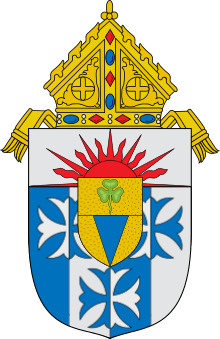University of Providence
| Motto | In lumine tuo, videmus lumen |
|---|---|
Motto in English | In Thy Light We See Light |
| Type | Private |
| Established | 1932 |
| Affiliation | Roman Catholic |
| President | Dr. Tony Aretz |
| Undergraduates | 1,100 |
| Location | Great Falls, Montana, United States |
| Athletics | NAIA |
| Nickname | Argonauts |
| Affiliations | Frontier Conference |
| Website | https://www.uprovidence.edu/ |
Coordinates: 47°29′30″N 111°16′14″W / 47.4916°N 111.2706°W
The University of Providence (UP) (renamed from University of Great Falls in July 2017[1]) is a private Roman Catholic university located in Great Falls, Montana, United States, within the Diocese of Great Falls–Billings. The university is accredited by the Northwest Association of Schools and Colleges. The University's mission "is to provide students with the opportunity to obtain a liberal education for living and for making a living."
History
The University of Providence was founded in 1932 as Great Falls Junior College for Women by Edwin Vincent O'Hara, the Catholic Bishop of Great Falls, in collaboration with the Sisters of Charity of Providence and the Ursuline Sisters. It became coeducational in 1937.
A year later, Sister Lucia Sullivan established the Great Falls Normal School to educate teachers. At the time there were two schools, each operating under a different Catholic religious community. The union of the two schools was one of convenience and legality. In 1942, the institution was a single entity under the direction of the Sisters of Providence, and was renamed the Great Falls College of Education. By the early 1950s it became simply the College of Great Falls, and in 1995 was renamed the University of Great Falls. It was renamed University of Providence in July 2017.[1]
Over the years UP has been involved in several outreach education efforts. For many years, it has had a resident center on the Fort Belknap Indian Reservation, and in Lewistown, as well as a continuing education program at Malmstrom Air Force Base. In addition to its campus offerings, UP serves 31 sites in Montana, southern Alberta and Wyoming through its Telecom Distance Learning Program, and is able to serve students around the world. The University of Providence offers undergraduate degrees in more than 20 programs and several master's degree programs.
The student body consists of approximately 1,100 undergraduate students and 200 graduate students.
Programs
The UP undergraduate program consists of two schools:
- The School of Liberal Arts and Sciences, which includes Arts and Humanities; Business Administration; Education; History, Language and Literature; Mathematics and Sciences
- The School of Health Professions, which contains Nursing, Epidemiology, Organizational Leadership, and Applied Health Informatics
Some of the more popular programs are criminal justice, human services, elementary education, counseling psychology, and paralegal studies. The school also offers teaching certificates.
The university offers the following master's degree programs:
- Master of Science in Counseling (MSC)
- Master of Science in Organizational Leadership (MSL) with concentrations in Accounting, Criminal Justice, Healthcare Administration, and Management. The MSL is an online program.
UP's calendar consists of four-month semesters in the fall and spring, and a 12-week summer term.
Athletics
Providence teams, nicknamed athletically the Argonauts, are part of the National Association of Intercollegiate Athletics (NAIA), primarily competing in the Frontier Conference. Men's sports include basketball, cross country, golf, lacrosse, rodeo, soccer, track & field and wrestling; women's sports include basketball, cross country, golf, rodeo, soccer, softball, track & field, volleyball, and wrestling. Providence recently added men's and women's ice hockey as varsity sports, both scheduled to start in the fall of 2018. Co-ed sports include the spirit squad.
Admissions
The University of Providence has a rolling admission policy. Applications are considered without regard to race, gender, age, religion, marital status, sexual orientation, financial status, physical or mental disabilities, or national origin. Applicants may apply for admission at any time; however, they are strongly urged to apply at least one month prior to the first day of classes for the term they intend to begin. Required documents must be submitted before a student can be admitted. It is particularly important that the UP Placement Test be taken prior to registration. Prospective students must complete an admission application, which has no application fee, and provide an official high school transcript or official certificate of high school equivalency with scores from the General Education Development Test (GED). Results of ACT or SAT are recommended for academic advising and consideration for merit/no-need scholarships, but not required. To register, proof of two immunizations for measles and one immunization for rubella must be supplied.
Alumni
- Judith O'Brien Cole, Advisor of International Development/Public International Law, United Nations Legal Division/United States Department of State, Switzerland
- Mary Ann Epley, Executive Officer, U.S. Agency for International Development, Arlington, VA
- Agnes K. Fok, Ph.D., Faculty Emeriti, University of Hawaii at Manoa, former Director of Biology Program; research fields membrane biology, protein cloning and sequencing
- Paul G. Hatfield, United States Senator; Chief Justice of the Montana Supreme Court
- Karl Jorda, David Rines Professor of Intellectual Property Law and Industrial Innovation; Director of Kenneth J. Germeshausen Center for the Law of Innovation and Entrepreneurship, Franklin Pierce Law Center, New Hampshire
- Dennis R. Lassila, Ph.D. CPA, Shelton Tax Professor, Mays Business School at Texas A&M University; co-author of more than 25 professional and educational books and chapters of tax and banking law services
- Maj. Gen. Arthur B. Morrill III, Vice Director, Defense Logistics Agency, Fort Belvoir, VA
- Lee Ann Reminton, O.D., Professor of Optometry, Pacific University College of Optometry, Portland, Oregon; author of the textbook Clinical Anatomy of the Visual System
- Jon Tester, United States Senator from Montana
